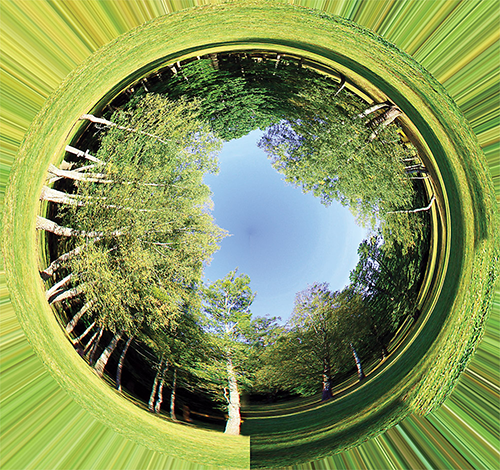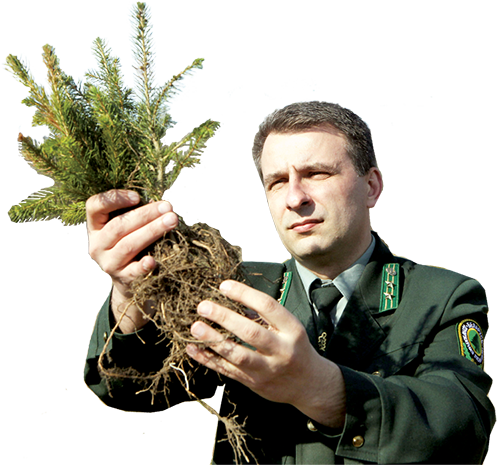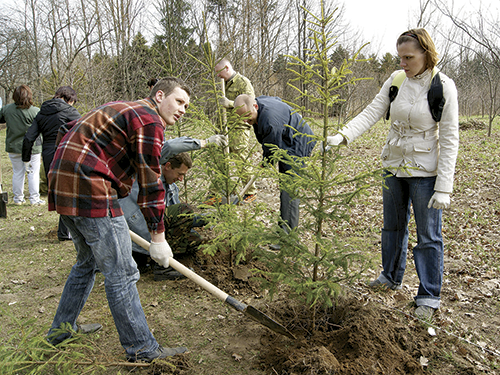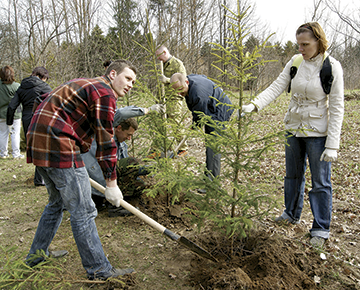
“A sandwich outdoors isn’t a sandwich anymore. It tastes different than indoors. It has more flavour. It tastes like mint and pinesap. It does wonders for the appetite.”
Ray Bradbury, Dandelion Wine
 Each of us has our own ‘romance’ with the forest. Mine began in my distant Ukrainian childhood, in the Kharkov District. The forest was visible from the mountain; I just needed to climb the slope of the ravine adjoining our garden. I liked to go there and look at the city in which I was born and lived until I finished school. When I first saw Volchansk from this height, it amazed me, because it seemed that it lay as if in someone’s large palm.
Each of us has our own ‘romance’ with the forest. Mine began in my distant Ukrainian childhood, in the Kharkov District. The forest was visible from the mountain; I just needed to climb the slope of the ravine adjoining our garden. I liked to go there and look at the city in which I was born and lived until I finished school. When I first saw Volchansk from this height, it amazed me, because it seemed that it lay as if in someone’s large palm.
My father told me that local elderly residents nicknamed the place where Volchansk’s ancient settlement first began (around 1100AD) a ‘wolf hole’. I liked that I lived directly in a ravine hole, on one side protected by a huge broad-leaved forest, and by high hills on the other. When we were children, we used to run to the forests to collect dark bluebells and primroses. They appeared in early April in forest-thawed patches.
Being 6km from the town, the Gatishchansky Forest seemed gloomy and mysterious, especially during bad weather. However, all my fears faded when I went for the first time on a summer sunny day to fish in the River Severski Donets. On the right bank was my ‘terrible’ forest from early childhood. Our whole family went: father, mother, brother with wife and daughter, and the nephew of my father — a military pilot.
I felt then for the first time, with all my soul, that the forest is a real miracle, with its sunny clearings, green grass, birds’ voices and the crackling of boughs. On that day, for the first time, I tasted wild strawberries, which I picked with my pilot cousin. Huge oaks, birches, alder trees and hazels surrounded us — so many different trees. My father, a veteran of the Great Patriotic War, advised us not to go too far into thickets which seemed denser as you rose, saying that the most severe fighting occurred there, during the retreat of our troops in 1941. He ordered me not to go there with friends when I become older, since people found a lot of shells in those places. He advised us to arrange picnics in closer forests, behind the airdrome, where there were many yellow boletuses, ceps and honey mushrooms, densely growing on old birch stumps. So we did.
We organised walking trips for violet willows, while observing planes take off. Basking in the sun, we arranged picnics, eating greedily all the food taken from the house. Of course, we picked mushrooms, although, not being the biggest fan and failing to know where they grew most abundantly in the Volchansk District, I don’t remember too much about it.
I recall that when I was 5, my mother’s younger brother brought me a gift from Gomel: a box of sweets on which a forest of fir trees was painted. “It’s our Belarusian forest,” said uncle Vanya. “When you come to visit us, you’ll see that Belarus is a country of forests.” It may have been at this moment that the threads of my destiny came together, since I’ve lived here for a long time and certainly feel like a local, to the core. Around 1996, over a period of four months, I hiked around the Belarusian state border — as you can read in another article in this edition. It was a journey that convinced me that the forest is a friend, defender and provider.

“If you go to the left, there will be simply forest; if you go to the right, there will be forest again. If you reach a hollow, then you’ll see a magic forest.”
From the film A Fairy Tale about Lost Time
 We go to the forest at the weekend, unless the weather is bad or there is other urgent business; I then wait impatiently until next time. Just five minutes’ drive from our city apartment is Tsnyanskoye water basin, surrounded by forest. We go further, along the bank of the Vyacha River, where the forest reaches the water. Then, we make our way towards the Logoisk District. Our friends’ summer cottage is located in the village of Pogrebishche, among Firs and Pines. In Posadets, we visit relatives, who also live near a forest. In fact, Zmitrok Byadulya, the Belarusian writer, was born there; his theatrical creativity and dramaturgy became the basis for my Master’s thesis. Sometimes, we visit the Brest Region, where there is a house owned by my husband’s parents.
We go to the forest at the weekend, unless the weather is bad or there is other urgent business; I then wait impatiently until next time. Just five minutes’ drive from our city apartment is Tsnyanskoye water basin, surrounded by forest. We go further, along the bank of the Vyacha River, where the forest reaches the water. Then, we make our way towards the Logoisk District. Our friends’ summer cottage is located in the village of Pogrebishche, among Firs and Pines. In Posadets, we visit relatives, who also live near a forest. In fact, Zmitrok Byadulya, the Belarusian writer, was born there; his theatrical creativity and dramaturgy became the basis for my Master’s thesis. Sometimes, we visit the Brest Region, where there is a house owned by my husband’s parents.
The small village of Yatskovshchina hides behind huge birches, maples and oaks, which stand on both sides of the Kletsk-Lyakhovichi highway. Nearby is Alitskovshina, where the forest is mixed. Just 50m from the house is a new forest, planted to protect us from the wind. It brings silence to our farmstead, where the tops of the old apple-trees hardly move, although the trees near the road ‘groan’ in the wind. Forest lilies of the valley, bluebells and camomile flowers grow in the garden, probably brought with soil once from the forest, in order to plant blueberries. They’ve multiplied over time and now please the eye. Such is the aesthetic role of the forest. We’ve planted junipers in the garden, as well as several pines and oaks and one fir (now as tall as the roof). A few kilometres from Yatskovshchina is an ancient coniferous forest, called Antiquity. There, it seems that magic is hidden among the century-old pines and firs, which bewitch in the huge hollows. Local residents seldom go there, although there are many mushrooms.
Forest mysticism came to fore during a recent holiday with my husband; we kayaked down the River Niemen, starting in Stolbtsy and floating through the majestic Nalibokskaya Pushcha, which spreads out from the right bank of the Niemen. We spent the night in the forest, mooring to the steep bank, near a group of oaks. We pitched a tent, drank tea and went to sleep, but strange things began to happen: rustling and crackling boughs, and the cry of an eagle owl. My husband slept calmly, yet I could not. I knew that our tent ‘protected’ us but I allowed fear to take hold of me, irrationally. I imagined wild beasts in the forest: a wolf howling, an elk stepping on the tent or a wild boar attacking. I realise now that I was probably half-dreaming. I thought about the beautiful oak under which we had placed our tent, and how the ancestors of Belarusians were pagans, asking protection from trees. I think this awoke something within me at a deeper level. I envisioned the oak to be a handsome ‘strongman’ guarding me and quickly fell asleep. In the morning, chuckling at my fears, I thanked the oak, which looked so innocent in the early sunlight: my night defender. I walked along the bank, picking puffballs and mushrooms with white hats, which have flesh as thick as chicken meat. In the twilight mist, we hadn’t seen them the previous evening near a sandy shallow pool (where we then bathed before departure). That evening, we ate mushroom soup — and how very tasty it was!

The tradition to plant forests has a long history in Belarus
“...When I hear how a young forest planted at my hand whirrs, I realise that the landscape is a little within my power and that, if in one thousand years humans are happy, I will be partly responsible.”
Anton Chekhov, Uncle Vanya
 Recently, I read two related books: Searchers of the Sky by Sergey Lukyanenko — a popular Russian writer; and a second book of his, called Morning Approaches. The forest appears largely in both, as is popular now in Belarus. He writes:
Recently, I read two related books: Searchers of the Sky by Sergey Lukyanenko — a popular Russian writer; and a second book of his, called Morning Approaches. The forest appears largely in both, as is popular now in Belarus. He writes:
“It’s always difficult to build. When you’re hungry and you need a field [in which to grow crops], you burn a forest. You become a fire, and century-old trees quickly turn to ash. However, the day then comes when you understand that you need trees. In order to build a house, and stoke your home hearth, you seek shelter and you plant a forest. Day after day, year after year, you wait, knowing that a forest cannot rise during your lifetime. You have a purpose but you’ll never reach it. You can think only about those who will come after you. You become unified with the wider world, with the past and future…”
Probably, those who planted forests this spring, felt this connection. After all, they were doing the good deed not for themselves but for future generations: a forest does not grow quickly. To remind readers, the Forest Week has been held for the 8th time recently in Belarus, coinciding with the 70th anniversary of our liberation from the Fascist aggressors. In memory of victims, commemorative trees were planted at the Mound of Glory Memorial. The baton was then passed countrywide, with around 50,000 people taking part. TV programme 24 Hour News reported that 70 million trees are to be planted in honour of 70 peaceful years. The tradition of planting forests began in the 1930s, beginning with a Forest Day rather than a whole week. The Forestry Ministry, which is responsible for the safety and augmentation of forests, revived the idea in 2007 and, every year, it becomes greater in scale, showing that Belarusians appreciate their forest riches.

Useful profession of the logger
— Some people can’t imagine what you can make from one cubic metre of forest timber. Do you, for example?
— I know! Firewood! Sleepers for railway lines!
—You know more about potatoes! From one cubic metre of forest, you can make 200kg of paper or 170 pairs of rubber galoshes, two car tyres or 180kg of wool. For example, your mittens: you think that they are made from wool, yes?
— Yes...
— No, from a fir tree. My scarf is similar.
— From a fir tree too?
— No, from pine. Your small hands are frozen, while the forest warms all mankind.
— Oh, you’re such a know-it-all with your forest tales!
From the Soviet era cult film Devchata (Girls)
 The forests of Belarus are a rich source, forming the basis of the timber industry; they provide food and medicinal resources, as well as various other goods. Some inhabitants of forest villages even today live from what grows there: selling to the state mushrooms, berries, honey, cranberries and cowberries. This year’s mushroom season was so plentiful that professional pickers sold them to mushroom canneries: there are over 70 such in the Brest Region alone, which work for two months of the year. Besides mushrooms, nuts, berries and herbs, we reap the soft resin of trees, their roots and trunks. We even use Birch bark. The forestry of Belarus is one of the most promising Belarusian economic branches of raw materials.
The forests of Belarus are a rich source, forming the basis of the timber industry; they provide food and medicinal resources, as well as various other goods. Some inhabitants of forest villages even today live from what grows there: selling to the state mushrooms, berries, honey, cranberries and cowberries. This year’s mushroom season was so plentiful that professional pickers sold them to mushroom canneries: there are over 70 such in the Brest Region alone, which work for two months of the year. Besides mushrooms, nuts, berries and herbs, we reap the soft resin of trees, their roots and trunks. We even use Birch bark. The forestry of Belarus is one of the most promising Belarusian economic branches of raw materials.
The country has well-developed timber, wood processing and pulp and paper industries. The forest complex of Belarus includes about 5,000 enterprises, including over 470 large and medium-sized, employing about 150,000 people, processing timber, wood particle and wood-fibre boards, veneer and furniture. About 300 enterprises produce furniture. Minsk, Bobruisk, Gomel, Vitebsk, Pinsk. Borisov, Gomel and Pinsk have enterprises producing matches; these are among the oldest countrywide, dating from the late 19th century. Sawn timber and veneer have been produced for over two centuries, and are now processed in Borisov, Bobruisk, Vitebsk, Gomel, Pinsk, Mosty, Rechitsa and Ivatsevichi.
Belarusian forest services and goods are exported to more than 25 countries, including Poland, Lithuania, Germany, Latvia, Sweden, Belgium and the Netherlands. The Belarusian President, during his visit to the Republican Forest Selection Seed Growing Centre, this August, forbade the export of unprocessed timber in 2016, necessitating value-added processing. In order to meet the standards of advanced countries, such as Finland, modernisation of wood-processing enterprises is underway. Meanwhile, to keep them operating at full capacity, forestry work is being closely co-ordinated with enterprises’ needs. The President toured the biotechnological laboratory at the Centre, which works in co-operation with Polesie State University. It’s attempting the cloning of arboreal-dumetosous varieties for the first time, which should inspire advantages in cultivating planting stock, reducing growing time from 15 years to just 3-5.
You can read the full article here.
Interestingly, Belarusian forests quickly adapt to changing environmental conditions, including growing on ‘non-native’ soil. Our seeds are in demand, for example, by the Scandinavians, and in great volumes.
“For some time, I’ve been thinking that this wood, forms part of my ‘ego’. I’ve wandered inside myself, just as blood circulates through my veins. I’ve seen my inner world; what appeared threatening was simply the echo of my inner fears. The web entangling me is a spider network, spread across my heart. Birds twittering overhead are from my own imagination: born from roots in my head.”
Haruki Murakami Kafka on the Shore
 How many roles does the forest have? In my opinion, many, each as important as any other. It’s difficult to separate them, since these roles are interconnected. One is spiritual, encouraging us to stand alone, pondering eternal values. For me, the forest is like a huge temple: its domes are the tops of trees, beckoning high into the air. If you look into the sky for long enough, you seem to enter another reality, listening to the silence of another world, ruled by tranquillity. The forest cures not only our body but our soul. It cleanses vanity, showing us that our life is priceless and that all is wisely arranged in the world. We need only live simply, without causing harm to the land, working and rejoicing. The forest helps us to embrace this pleasure. I’ve never met anyone who doesn’t like the forest.
How many roles does the forest have? In my opinion, many, each as important as any other. It’s difficult to separate them, since these roles are interconnected. One is spiritual, encouraging us to stand alone, pondering eternal values. For me, the forest is like a huge temple: its domes are the tops of trees, beckoning high into the air. If you look into the sky for long enough, you seem to enter another reality, listening to the silence of another world, ruled by tranquillity. The forest cures not only our body but our soul. It cleanses vanity, showing us that our life is priceless and that all is wisely arranged in the world. We need only live simply, without causing harm to the land, working and rejoicing. The forest helps us to embrace this pleasure. I’ve never met anyone who doesn’t like the forest.
Belarusian forests cover about 9.5 million hectares: 39.3 percent of the territory. Its wood stock is estimated at 1.7 billion cubic metres and the annual gain is over 31.9 million cubic metres of wood.
By Valentina Zhdanovich











